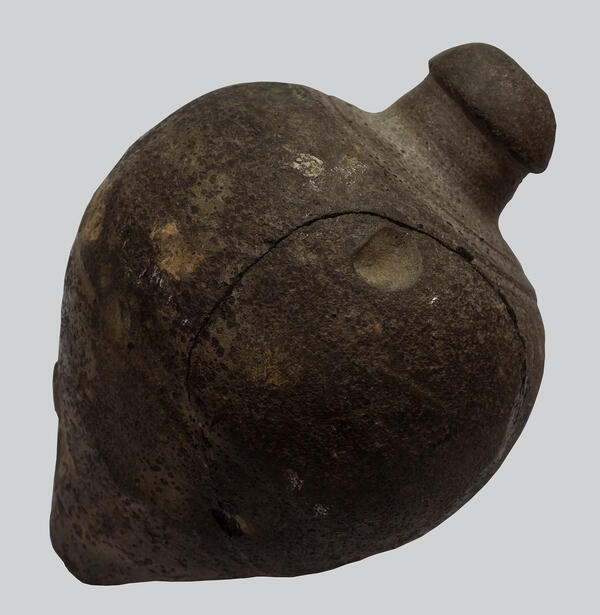This small spherical cone was discovered during excavations near the ChAshkinskoye Lake in 1991. The vessel is of gray-green color, which is typical for Central Asian spherical cones of the 10th – 12th centuries. There is a tamga, a tribe emblem in the form of two-piece ring riding bits on the wall of the spherical cone. It was crafted quite likely after firing.
The features of such spherical cone vessels are thick walls, a narrow neck and a small opening. The height of the vessels varied from 8 to 30 centimeters. Due to the small hole diameter, 4-10 millimeters, and the conical bottom of the vessel, the contents did not spill. Due to this shape of the bottom the vessel could only lie on its side.
Most of the vessels found during the excavations of the Bulgar monuments are made of clay. To manufacture spherical cones, high-quality clay was used, the walls were made thick. After firing, such vessels gained refractory properties.
Over two centuries, researchers have put forward different versions of the purpose of such vessels. According to one of the first versions, it was assumed that the spherical cones were used as grenades. The narrow neck served to fit the wick in, the thick walls intensified the explosion, and the inner wax protected the contents from impacts.
According to the second version, the spherical cones were used during the sieges. At first, vessels filled with oil were being thrown off the fortress walls to spill the content over a large area. Then the second batch of spherical cones filled with a burning liquid was dropped. As a result of such tactics, a significant part of the enemy immediately turned out to be on fire.
Scientists of the second half of the 19th century assumed that Spherical Cones were used as lamps. For this, fat or oil could be poured inside. In order for the vessel to stand upright, a stand was needed, which could be made of wood. However, this hypothesis did not find support among modern researchers, firstly, because of the massive finds of Spherical Cones and lamps, and secondly there is no any soot on the neck of the vessels.
According to another version, the spherical cones were used to carry and store mercury supplied from Central Asia. Perm archaeologists suggest that the Spherical Cone found near the ChAshkinskoye Lake was also intended to keep mercury used in the metallurgical operations.
During the early Middle Ages, there was a center of metallurgy in the area of ChAshkinskoye Lake near modern BereznikI. Archaeologists have found in these places numerous evidences of the development of non-ferrous metallurgy - a variety of objects and tools associated with bronze casting and the processing of non-ferrous metal products.
Finally, according to another version of historians, such vessels could be used to carry water, oils and incense. At present, researchers are leaning towards the version of the multifunctional spherical cones and their use in those industries that needed the density, hardness and shape of vessels - alchemy, metallurgy, medicine, perfumery and others.
The features of such spherical cone vessels are thick walls, a narrow neck and a small opening. The height of the vessels varied from 8 to 30 centimeters. Due to the small hole diameter, 4-10 millimeters, and the conical bottom of the vessel, the contents did not spill. Due to this shape of the bottom the vessel could only lie on its side.
Most of the vessels found during the excavations of the Bulgar monuments are made of clay. To manufacture spherical cones, high-quality clay was used, the walls were made thick. After firing, such vessels gained refractory properties.
Over two centuries, researchers have put forward different versions of the purpose of such vessels. According to one of the first versions, it was assumed that the spherical cones were used as grenades. The narrow neck served to fit the wick in, the thick walls intensified the explosion, and the inner wax protected the contents from impacts.
According to the second version, the spherical cones were used during the sieges. At first, vessels filled with oil were being thrown off the fortress walls to spill the content over a large area. Then the second batch of spherical cones filled with a burning liquid was dropped. As a result of such tactics, a significant part of the enemy immediately turned out to be on fire.
Scientists of the second half of the 19th century assumed that Spherical Cones were used as lamps. For this, fat or oil could be poured inside. In order for the vessel to stand upright, a stand was needed, which could be made of wood. However, this hypothesis did not find support among modern researchers, firstly, because of the massive finds of Spherical Cones and lamps, and secondly there is no any soot on the neck of the vessels.
According to another version, the spherical cones were used to carry and store mercury supplied from Central Asia. Perm archaeologists suggest that the Spherical Cone found near the ChAshkinskoye Lake was also intended to keep mercury used in the metallurgical operations.
During the early Middle Ages, there was a center of metallurgy in the area of ChAshkinskoye Lake near modern BereznikI. Archaeologists have found in these places numerous evidences of the development of non-ferrous metallurgy - a variety of objects and tools associated with bronze casting and the processing of non-ferrous metal products.
Finally, according to another version of historians, such vessels could be used to carry water, oils and incense. At present, researchers are leaning towards the version of the multifunctional spherical cones and their use in those industries that needed the density, hardness and shape of vessels - alchemy, metallurgy, medicine, perfumery and others.



